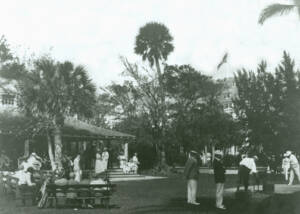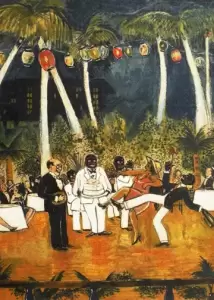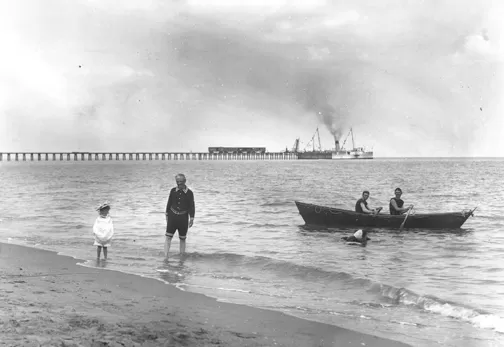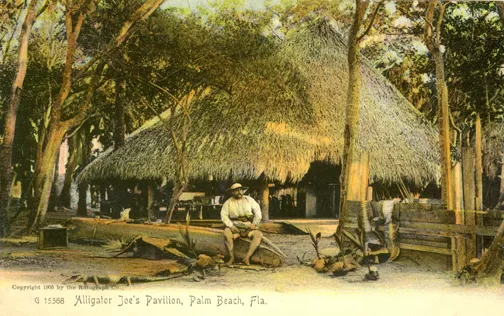Hotel Life: Seasonal Amusements

Palm Beach had a short “season” in the early years. In 1896 the Royal Poinciana advertised being open January to April, and The Breakers, from December to May. Year-round residents, however, recalled it closing on the 22nd of February after the annual Washington Ball, held alternately at the two grand hotels. According to Marjorie Potter Stewart, a week later the only people left in Palm Beach were the few that had homes, but they did not stay much longer. Palm Beach’s Palm Beach Daily News, also known as the “Shiny Sheet,” described the event this way: “When last night the guests stepped into the vast dining room of the Royal Poinciana for the 34th ball, they were swept back through the ages to the Babylonian beauty of song and story.”
For daytime amusement, Flagler added a building between the two hotels for the Palm Beach Golf Club in 1897, near the first tee. Caddies or players created individual tees in a tee box where they gathered wet sand from buckets, mounded it up in the tee box, and placed the ball on top of the mound for the first swing. The nine-hole course, designed by Alexander H. Findlay, was only available to guests of Flagler’s two hotels. Donald Ross designed a second course in 1916 on the highest, hilliest ocean-to-lake site that was available on the island; today it is Palm Beach Country Club.
Although the Breakers had a salt-water swimming pool, “everyone” went sunbathing at the beach, according to Phillips:
It was something to see Connie Lewis policing the beach to make sure that all the ladies wore dark stockings, and that not an inch of pink flesh showed between the skirts of the bathing suits and the hosiery. The great pier was a place for fishermen and for lovers at night.
Phillips
“The great pier,” destoryed in the 1928 hurricane, was a thousand feet long. When the railroad was extended to Palm Beach, for a time it ran onto the pier, where cargo and passengers could continue to Cuba or Nassau on Flagler’s P & O Steamship Line.
Another popular attraction on the island was Cragin’s Reve d’Été (Dream of Summer). Charles and Frances Cragin created a magnificent 35-acre “Garden of Eden,” as their property was often called, and made it available for visitors to tour.
Day in the Life
The following is based on author Donald W. Curl’s description of a typical day as a visitor to Palm Beach’s grand hotels, from Palm Beach County: An Illustrated History:
After breakfast, you went to the beach until lunch, taking the mule car, and then in the afternoon you rocked on the porches of the hotel, where you met everybody that counted. If you were energetic, you went sightseeing. On the pine walk between the Royal Poinciana and The Breakers, or along the Lake Trail, you could rent a wheelchair to take you to Alligator Joe’s or Cragin’s Garden of Eden. The really energetic could go fishing or hunting or play golf or tennis. Then you got dressed rather formally and went to the Cocoanut Grove at the Royal Poinciana for tea, dancing, gossip, and Mrs. Roche’s famous coconut cake. Then you dressed more formally and dined at the Grille Room of the Royal Poinciana for dinner or to Bradley’s Beach Club. Colonel Bradley only waived the rules of dress if you were planning to catch a late train and needed to be dressed for the train.
The Cake Walk
The moonlight cakewalks are among the most characteristic and picturesque of Palm Beach functions. One was held this week in the Cocoanut Grove, which is a part of the Royal Poinciana gardens. With the tall cocoanut palms hung with colored lights and a thousand spectators around the flooring on the lawn—most of the men in straw hats and dinner coats and the women, hatless, in elaborate evening gowns—it is difficult to describe the odd charm of this open air function. Joseph Jefferson [and others] have thus far this season been elevated to the bench as cakewalk judges.

The Cake Walk was a mainstay of the hotels’ entertainment for decades. In 1916, the best dance couples were awarded $100, $50, and $25 in addition to “the great frosted cake.” In 1930 the entertainers in the Cocoanut Grove, called the Darktown Strutters, still drew over 500 viewers for “their syncopated stuff” to tunes such as “Too Much Mustard,” “Waiting for the Robert E. Lee,” or “The Charleston.”
Alligator Joe
Alligator Joe’s, located near today’s Worth Avenue, was one of the most popular Palm Beach tourist attractions in the early 1900s. The owner, born Warren Frazee, entertained the crowds by wrestling alligators. There were hundreds of these large reptiles on his farm, along with turtles, manatees, and other native creatures. One of his shows in 1907 featured a 200-pound, 12-foot-long crocodile, which he towed out into the ocean, was covered by The New York Times:
[Frazee] released it, then made a quick jump and landed stomach down on the creature’s back. Over and over they went, like boys wrestling. Gradually [Frazee] worked the reptile to a steep bank. A rope was thrown to him. Keeping the crocodile under water, he tied the cord around its long snout in two places. It was then dragged ashore. Alligator Joe was known throughout the nation and ran alligator attractions in the Midwest. He died in 1915 in San Francisco during the Pan American Exopsition where he was displaying some of his "exotic" animals.



